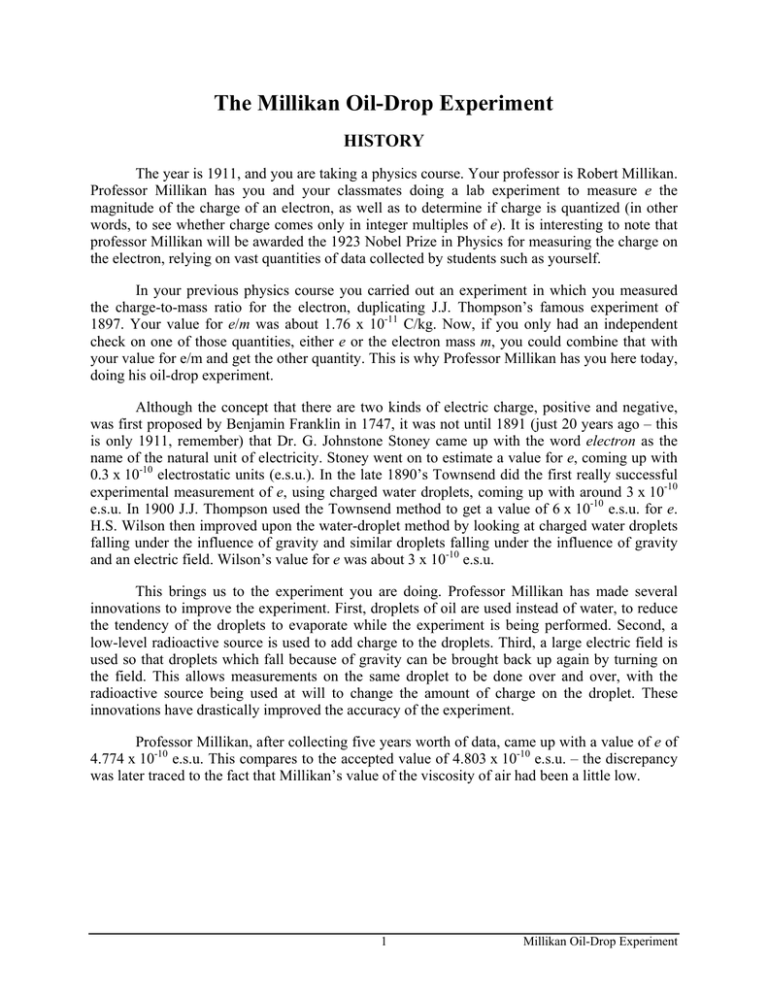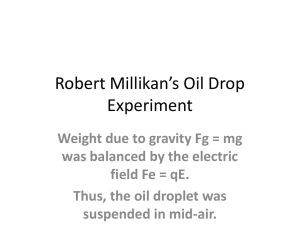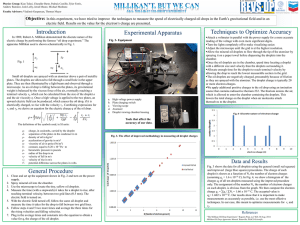The Millikan Oil-Drop Experiment
advertisement

The Millikan Oil-Drop Experiment HISTORY The year is 1911, and you are taking a physics course. Your professor is Robert Millikan. Professor Millikan has you and your classmates doing a lab experiment to measure e the magnitude of the charge of an electron, as well as to determine if charge is quantized (in other words, to see whether charge comes only in integer multiples of e). It is interesting to note that professor Millikan will be awarded the 1923 Nobel Prize in Physics for measuring the charge on the electron, relying on vast quantities of data collected by students such as yourself. In your previous physics course you carried out an experiment in which you measured the charge-to-mass ratio for the electron, duplicating J.J. Thompson’s famous experiment of 1897. Your value for e/m was about 1.76 x 10-11 C/kg. Now, if you only had an independent check on one of those quantities, either e or the electron mass m, you could combine that with your value for e/m and get the other quantity. This is why Professor Millikan has you here today, doing his oil-drop experiment. Although the concept that there are two kinds of electric charge, positive and negative, was first proposed by Benjamin Franklin in 1747, it was not until 1891 (just 20 years ago – this is only 1911, remember) that Dr. G. Johnstone Stoney came up with the word electron as the name of the natural unit of electricity. Stoney went on to estimate a value for e, coming up with 0.3 x 10-10 electrostatic units (e.s.u.). In the late 1890’s Townsend did the first really successful experimental measurement of e, using charged water droplets, coming up with around 3 x 10-10 e.s.u. In 1900 J.J. Thompson used the Townsend method to get a value of 6 x 10-10 e.s.u. for e. H.S. Wilson then improved upon the water-droplet method by looking at charged water droplets falling under the influence of gravity and similar droplets falling under the influence of gravity and an electric field. Wilson’s value for e was about 3 x 10-10 e.s.u. This brings us to the experiment you are doing. Professor Millikan has made several innovations to improve the experiment. First, droplets of oil are used instead of water, to reduce the tendency of the droplets to evaporate while the experiment is being performed. Second, a low-level radioactive source is used to add charge to the droplets. Third, a large electric field is used so that droplets which fall because of gravity can be brought back up again by turning on the field. This allows measurements on the same droplet to be done over and over, with the radioactive source being used at will to change the amount of charge on the droplet. These innovations have drastically improved the accuracy of the experiment. Professor Millikan, after collecting five years worth of data, came up with a value of e of 4.774 x 10-10 e.s.u. This compares to the accepted value of 4.803 x 10-10 e.s.u. – the discrepancy was later traced to the fact that Millikan’s value of the viscosity of air had been a little low. 1 Millikan Oil-Drop Experiment THEORY In this experiment you will use tiny droplets of oil. When these droplets fall under the influence of gravity it takes them only a few milliseconds to reach a terminal (constant) speed vf, where the downward force of gravity is balanced by the upward drag force from the air. The drag force is proportional to the velocity, giving the balanced forces shown in Figure 1. If the oil droplet is negatively charged, applying an electric field E down gives an upward force up on the droplet. Assuming the field is sufficiently large the droplet can rise with a constant speed vr, giving the balanced forces shown in Figure 2. You should convince yourself that combining the two force relationships represented by the figures above, and then solving for the magnitude of the charge on the droplet, gives: q= mg (v r + v f ) Ev f Equation 1 In our experiment the electric field E will be created by a parallel-plate capacitor, so we can use the relationship E = V / d , where V is the capacitor voltage and d is the distance between the capacitor plates. This gives: q= mgd (v r + v f ) Equation 2 Vv f The mass we can find using the fact the each droplet is a sphere of radius a, and mass is density multiplied by volume. Thus: 4 m = πa 3 ρ 3 Equation 3 The next problem is finding the radius of a droplet. This is too small to measure directly, so we will use Stokes’ Law. Stokes’ Law tells us that the terminal speed of a droplet falling in a viscous medium (air, in our case) with a viscosity η is related to the radius a of the droplet by the following: 9ηv f a = 2 gρ Equation 4 Stokes’ Law applies when the terminal speed is at least 0.1 cm/s, which is 10 to 100 times larger than the terminal speeds of the droplets we will use. To correct for this we simply use an effective viscosity, given by: 2 Millikan Oil-Drop Experiment η eff 1 = η b 1+ Pa Equation 5 where b is a constant, P is atmospheric pressure, and a is the radius given by equation 3. Substituting equation 5 into equation 4 and solving for the droplet radius gives: 2 9ηv f b b − a= + 2 gρ 2 P 2P Equation 6 In your calculations for this experiment you will first use equation 6 to find the radius of a particular droplet, and then use equation 3 to find the mass of the droplet. To minimize the number of times you’ll need to do this sequence of calculations, you should use a droplet as many times as you can. Finally, you can use equation 2 to find the charge of the droplet, and you should be able to change the charge on a given droplet as the experiment proceeds. To carry out the calculations you will need to know the following: b = 8.20 x 10-3 Pa m ρ is the density of the oil, which is about 886 kg/m3 (you may want to determine a more accurate value for yourself). P is the current atmospheric pressure, which you should measure using the barometer in the lab. η is the viscosity of the air, which depends on temperature. After finding the temperature you can read the viscosity off the graph in Appendix A. values of d, V, vf, and vr you will determine through measurement 3 Millikan Oil-Drop Experiment APPARATUS To determine the charge on each of your oil droplets you will use the equipment in the figure on the right. A more detailed view of the platform is shown below. 4 Millikan Oil-Drop Experiment EQUIPMENT SET-UP There are several things to do before taking measurements of the speed at which a particular drop travels. These items include: 1. Measure d, the plate separation of the capacitor. Disassemble the droplet viewing chamber by lifting the housing straight up and then removing the upper capacitor plate and spacer (figure 5). d, the thickness of the plastic spacer, can be measured with a micrometer. Make sure you do not include the raised rim of the spacer in your measurement. Handle the brass plates and plastic spacer carefully to avoid scratching them. 2. Make sure the apparatus is level. First, adjust the height so you can sit erect while looking through the viewing scope (figure 6). Then, referring to the attached bubble level, adjust the leveling feet of the platform. 5 Millikan Oil-Drop Experiment 3. Focus the viewing scope by following this procedure: • Reassemble the plastic spacer and top capacitor plate onto the lower capacitor plate. Replace the housing, aligning the holes in its base with the housing pins (see figure 5). Note that the thorium source and the electrical connection to the lower capacitor plate fit into appropriately sized holes on the plastic spacer. • Unscrew the focusing wire from the platform and carefully insert it into the hole in the top capacitor plate (see figure 7). Then plug the 12volt DC transformer into the power jack in the halogen lamp housing and plug the apparatus into a wall socket. • Bring the reticle (the grid you will use for measurements) into focus by turning the reticle focusing ring. • Look through the viewing scope and bring the wire into sharp focus by turning the droplet focusing ring. If you wear glasses you may find it easier to take your glasses off when focusing and viewing. • Adjust the horizontal filament adjustment knob. The light is best focused when the right edge of the wire is brightest (in highest contrast compared to the center of the wire). • While looking through the viewing scope, turn the vertical filament adjustment knob until the light is brightest on the wire in the area of the reticle. • Return the focusing wire to its storage location on the platform. 6 Millikan Oil-Drop Experiment WHAT THE CONTROLS DO Ionization source lever • In the OFF position the ionization source is shielded by plastic, so the alpha particles cannot get through to the droplets. • In the ON position the shielding is removed, and the droplets are exposed to the ionizing alpha particles emitted by the thorium232 source. This should change the charge on the droplets. • In the Spray Droplet position the chamber is vented by a small air hole that allows air to escape when oil drops are being introduced to the chamber. The thorium-232 source has an activity level of 0.008 mC (millicuries). Thorium-232 is a naturally occurring, low-level alpha particle emitter. It is not regulated in its use and poses no hazard to the user of the apparatus. Plate charging switch • PLATES GROUNDED : use this to set the electric field on the capacitor to zero, and allow the droplets to fall under the influence of gravity alone. • TOP PLATE + : Sets up a downward-directed electric field in the capacitor. • TOP PLATE – : Sets up an upward-directed electric field in the capacitor. QUESTION 1: You will use the plate charging switch to drive the charged droplets up and down. If the droplets are negatively charged, which switch setting would you expect to use to cause the droplets to rise? 7 Millikan Oil-Drop Experiment THE EXPERIMENT PART I First, get set up to take measurements. The room lights should be turned off now. 1. Complete the reassembly of the droplet viewing chamber by placing the droplet hole cover on the top capacitor plate and then placing the lid on the housing (see figure 5). Note that the droplet hole cover has holes on the bottom and the side. 2. Connect the high-voltage DC power supply to the plate voltage connectors using bananaplug cords, and adjust to deliver about 380 V. Use the multimeter to measure this voltage at the plate voltage connectors. You will probably find it helpful to adjust the power supply voltage as you take measurements, to make it easier to track a particular droplet. 3. Find the temperature of the droplet viewing chamber. First, connect the multimeter to the thermistor connectors and measure the thermistor resistance. Then convert the resistance to temperature via the Thermistor Resistance Table (see the platform or Appendix A). 4. Knowing the temperature, use the graph in appendix B to find the viscosity of the air in the chamber. You should check the temperature every 15 minutes or so. 5. Introduce droplets into the chamber by following the procedure below. The goal is to get a small number of drops in the viewing area. Excessive use of the atomizer can produce too many drops. If you see too many drops either wait a few minutes until they settle out of view, or clear many away by connecting power to the capacitor plates for several seconds. If neither method works (or if your droplets don’t move at all) then turn off the DC power, disassemble and clean the droplet viewing chamber, and then reassemble it. • With the atomizer removed from the apparatus, place the mineral oil into the atomizer. Squeeze the bulb rapidly until oil sprays out. Make sure the tip of the atomizer is pointed down (see figure 9). • Move the ionization source lever to the Spray Droplet position. • Place the nozzle of the atomizer into the hole on the lid of the droplet viewing chamber. Look through the viewing scope, and give the atomizer one quick squeeze, followed by a slow squeeze to force the droplets into the space between the two capacitor plates. 8 Millikan Oil-Drop Experiment • When you see a shower of drops through the viewing scope, move the ionization source lever to the OFF position. 6. From the drops in view, select a droplet that both falls slowly (about 0.02-0.05 mm/s) when the plate charging switch is in the “Plates Grounded” position and can be driven up and down by turning on the voltage. If you cannot locate a charged droplet you can move the ionization lever to the ON position for about five seconds. Note that a drop that takes 15 seconds to fall the 0.5 mm distance between the major reticle lines will rise the same distance, under the influence of a 1000 V/cm electric field, in the following times: 15 s for 1 excess electron; 7 s for 2 excess electrons; 3 s for 3 excess electrons (approximately). Note also that the minor reticle lines are spaced 0.1 mm apart. 7. When you have selected a droplet with an appropriate size and charge, fine tune the focus of the viewing scope so the droplet appears as a bright pinpoint of light. PART II In this part of the experiment collect data on the rise and fall of the oil droplet. 1 Measure vf, the speed at which the droplet falls under the influence of gravity alone, and vr, the speed at which the droplet rises when the electric field is turned on. Use the plate voltage switch to move the droplet up or down to an appropriate starting position. You can achieve the greatest accuracy in your measurements if you time the droplet as it passes through the 0.5 mm distance between the first and second major reticle lines. Adjust the power supply voltage if you have trouble keeping a droplet in view. 2 Using the same droplet, repeat the measurements of its two speeds several times. Note that the droplet charge may change spontaneously, which would cause a change in the measured rising speed from one reading to the next. This is actually fine – do more speed measurements on the drop and treat these measurements as a second data set. 3 Use the procedure outlined at the end of the theory section to determine the charge on the droplet. If you find that this charge is larger than 5 excess electrons you should use slower-moving droplets in subsequent measurements. 4 At this point you can either try to change the charge on your droplet (as long as it does not already have more than 5 excess electrons) by turning the ionization lever to the ON position for a few seconds as the droplet falls, or you can select a new droplet to work with, either by choosing another that is already in view or by using the atomizer to introduce more droplets into the chamber. Each time you change the charge on a droplet, or use a new droplet, take several measurements of the droplet’s fall and rise speeds and then determine its charge. It is preferable to use the same drop as many times as you can, and change its charge, to minimize the amount of oil building up in the chamber as well as to minimize the number of calculations you need to do. 5 Take as many sets of data as you can. Measure the temperature of the viewing chamber every 15 minutes or so, so your value for the viscosity of air is as accurate as possible. 9 Millikan Oil-Drop Experiment 6 See if you can find a pattern in the set of calculated charges you obtain. QUESTIONS Note that Question 1 is on page 7 of this write-up. Question 2: What method(s) are you going to use to make sense of your data? Should you draw a graph? Plot a histogram? Describe any analysis methods you try. Question 3: One of the basic ideas you’re trying to test in this experiment is that charges come in integer multiples of e, the magnitude of the charge of an electron. Does your data support the idea that charge is found in integer multiples of some fundamental charge? Justify your answer. Question 4: Assuming your data does support an integer-multiple model, what is the value you determine for e? Question 5: Would you recommend to your professor that he include your data in his fiveyear study to measure the charge on the electron? Why or why not? Question 6: What are some possible sources of error in this experiment? If possible, discuss methods you could use to minimize these errors. Question 7: Another way to measure the charge on a droplet would have been to adjust the power-supply voltage until the upward electric force on the droplet exactly balanced the downward force of gravity, so the droplet hangs motionless in space. Comment on what you feel are the relative strengths and weaknesses of this method, compared to the procedure you followed. You might want to try it using the equipment before you comment. APPENDIX A 10 Millikan Oil-Drop Experiment APPENDIX B 11 Millikan Oil-Drop Experiment




